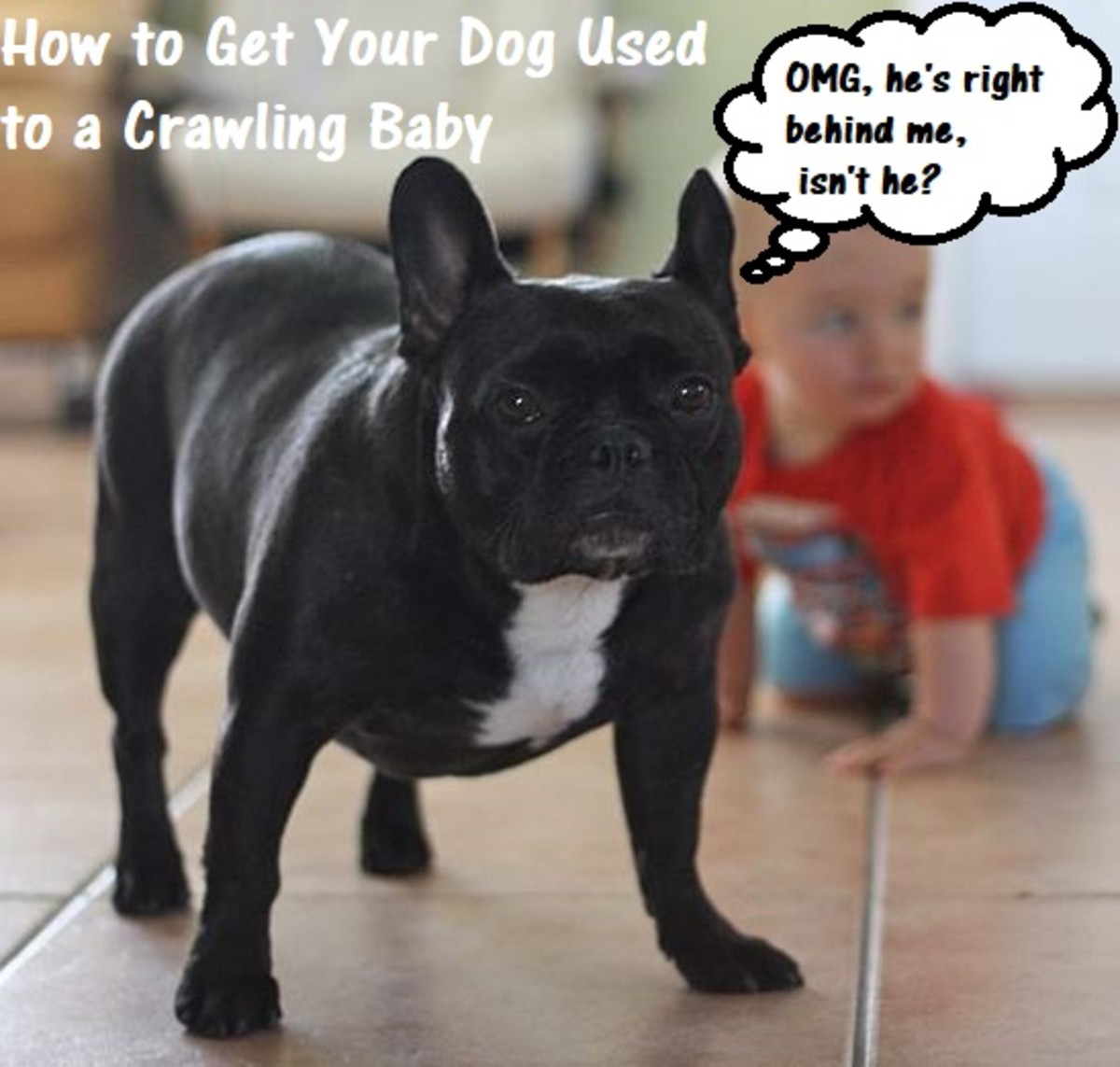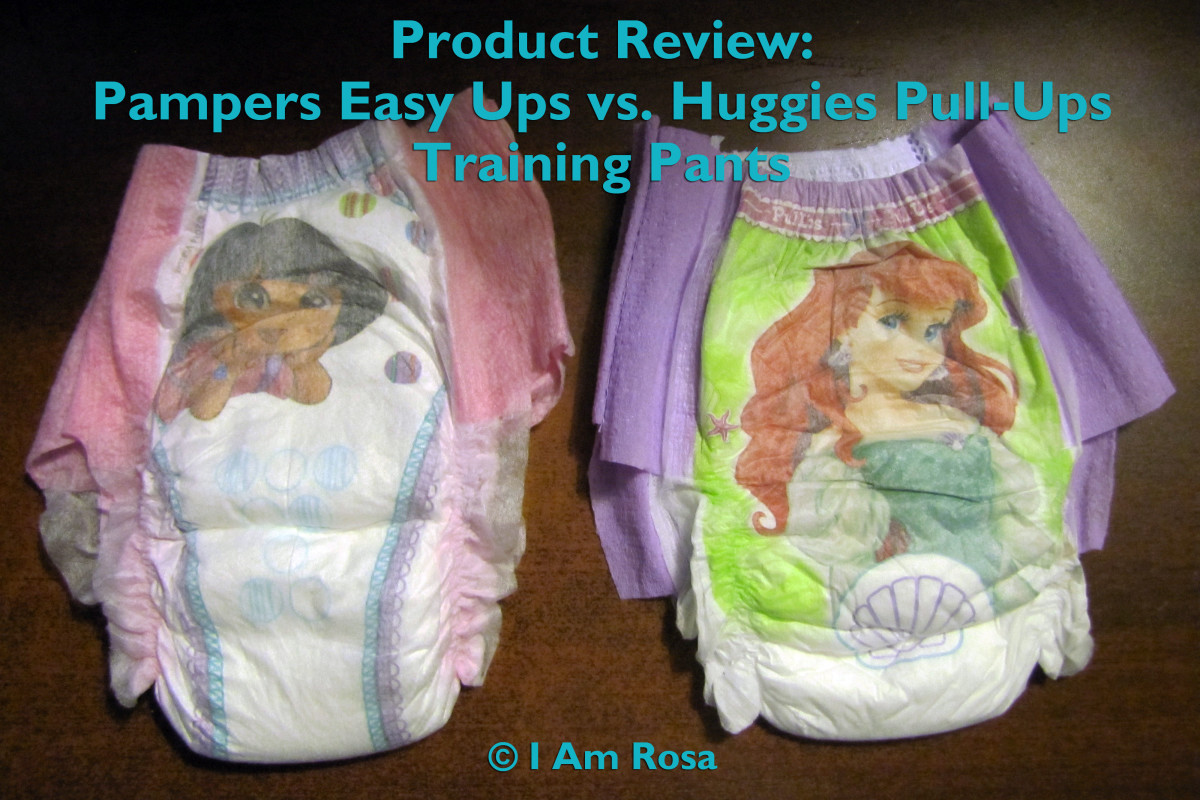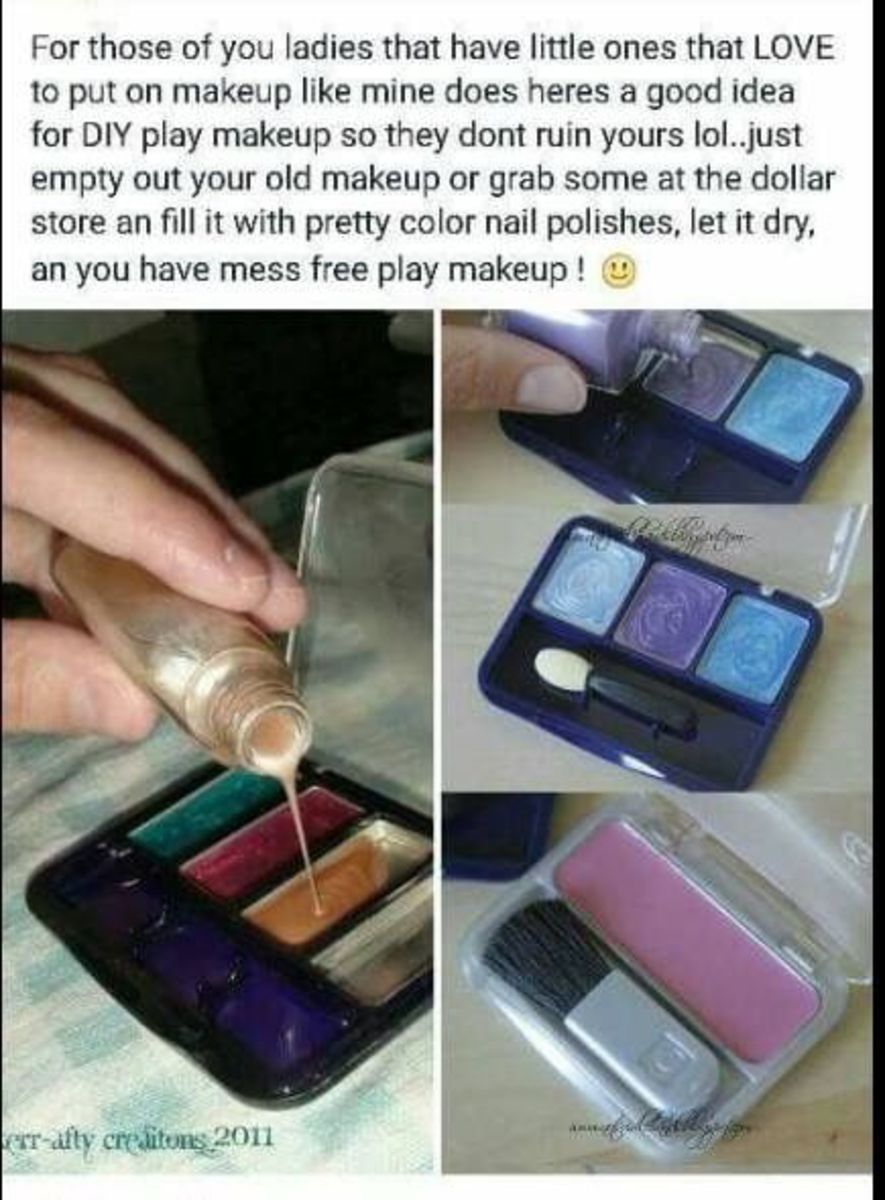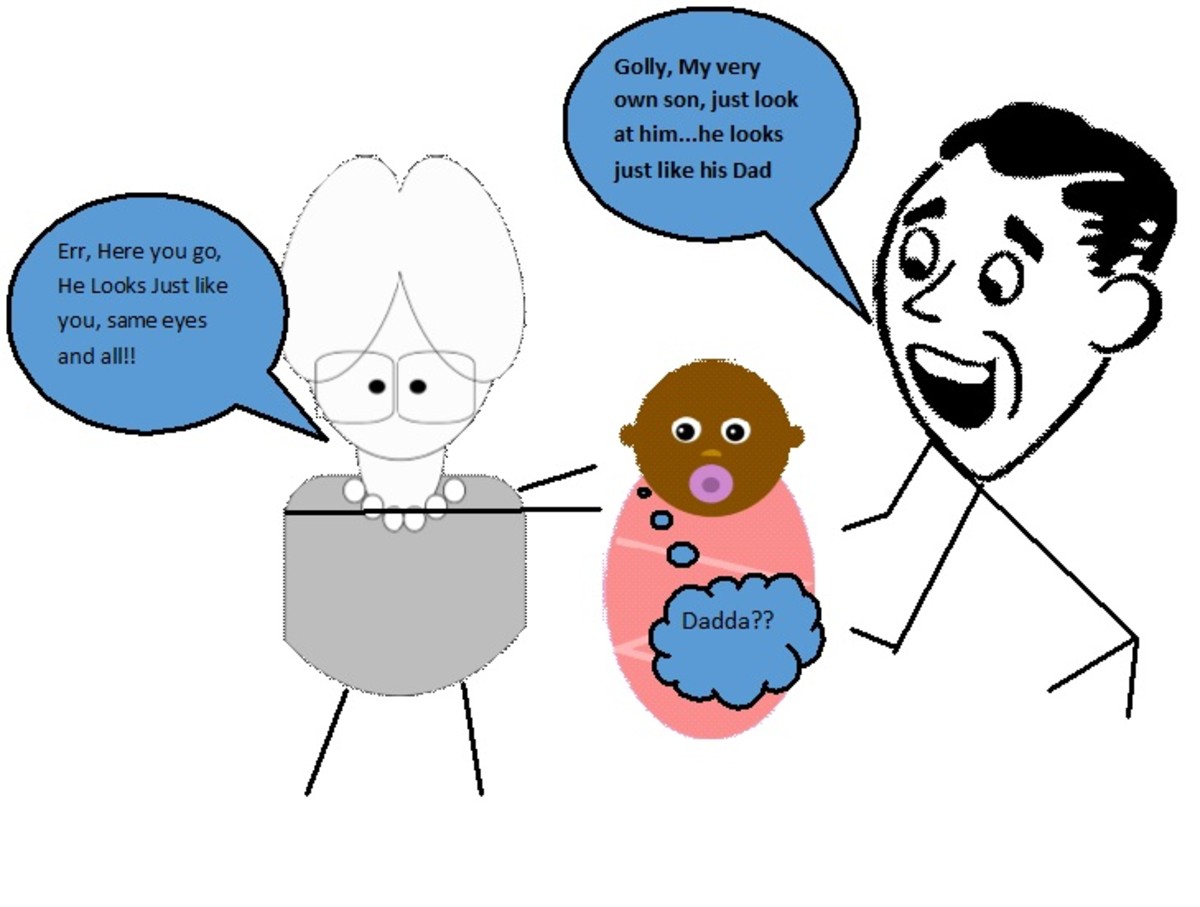Post #9: Imogen Rose In December, at ten months of age
Standing Imogen
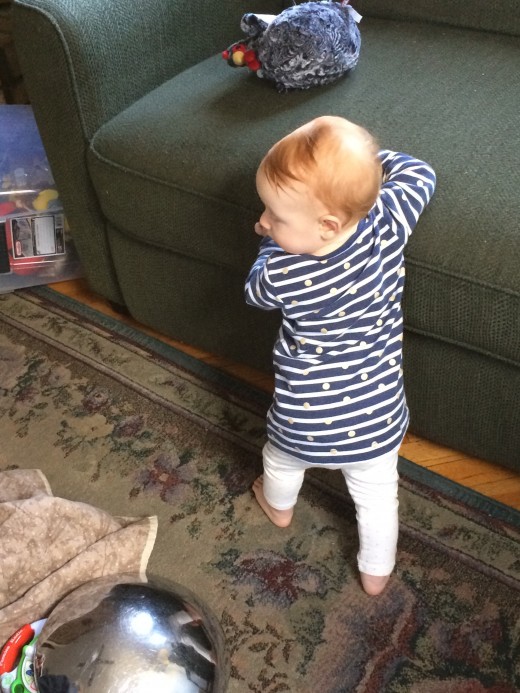
Large and small muscle Movement:
Crawling on hands and knees is the traditional way infants get around on their own efficiently. Most babies achieve this between seven and ten months of age. However, we now know that crawling may look different for different babies. Some babies scoot on their bottom, others do a commando crawl. Our youngest daughter did a crab-crawl with one foot up and the other on her knee. You don’t need to worry about your baby’s style, the important thing is that they are mobile.
Imogen is not picking up crawling as quickly as I expected her to, but her commando crawl gets her quickly where she wants to go. She is up on all fours, and crawling in the traditional way, and returns to the commando crawl when she wants to go fast.
In addition to crawling, Imogen pulls herself up to the couch and chair to standing and her most recent growth is to move along the couch or from one side of the chair to another. This is called “Cruising” and is the first step to walking. She is quite proficient at standing with only one hand holding something and sometimes standing without holding on to anything.
One thing we do now is add music to Imogen’s play time. I notice that she loves to ‘dance’ to the music while standing against the couch.
Standing and cruising
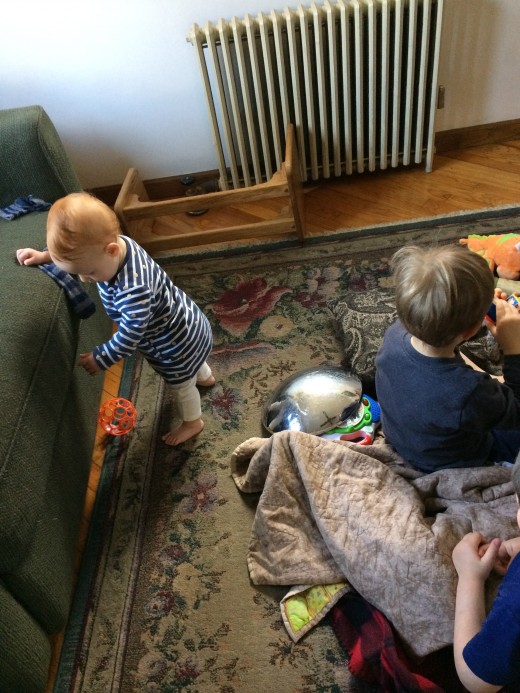
Communication:
Baby language is alive and well at our house. Imogen babbles and sometimes gives us quite a dissertation. We love to hear her baby talk. She looks at us and responds when we call her name. She looks to her grandpa when I ask her “where’s grandpa?”. She loves playing the peek-a-boo game with grandpa and laughs in response to my question.
She is also beginning to say words like ‘ma ma ma’ for wanting to nurse or get her bottle. She is giving us “raspberries” – the blowing air through tongue and lips. It cools her mouth and is a fun game to play with adults to encourage her mouth games. These mouth games help exercise the muscles she will need for talking.
Imogen does a full out "I’m angry” cry when her brother or cousin take her toy, so we are helping them learn to share, give her another toy before taking hers or ask her if they can have her toy before grabbing it from her. On the other hand, Imogen loves to take the boy’s toys as well, so now she is sometimes not wanted in their play. Imogen will protest when I move her to a different location so the boys can enjoy their dramatic play.
Imogen also uses gestures: waves, shakes her head, turns away from food she doesn’t want more. These are all normally developing communication skills that are right for her age. We are encouraging her communication by responding to her utterances and using baby sign language for important things like “Milk”, “Diaper”, “Sleep”, “Play”, and “Bye-bye”.
Many researchers believe language begins in utero as baby hears the sound of mother’s voice. After babies are born, they use different cries to tell us what they want, as well as a repertoire of sighs, coos and gurgles. Sometime before six months of age, babies begin combining consonants and vowels to make baby sounds like “ba ba ba ba” or “ma ma ma “. Later, your baby’s babbling may sound very organized and as if they are making sense. That’s because s/he is getting the patterns, rhythms and syntax of our language. Talking to your baby and reading to them will help continue growth in communication skills.
Sometime around your baby’s first year they will begin saying one to ten words and then their vocabulary will skyrocket so that by three years old, your child will carry on conversations with you.
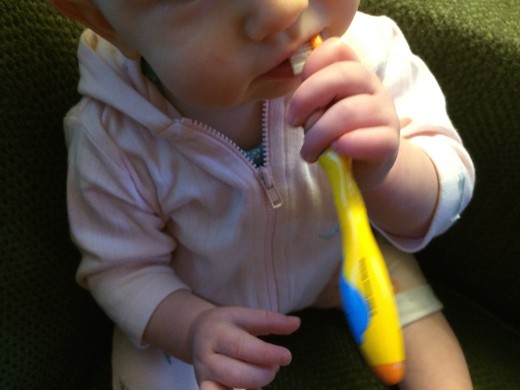
Teething:
Imogen has two bottom teeth, called the lower central incisors which are usually the first teeth to come in. Nevertheless, she continues to show signs of teething, which begins as early as three months or can hold off until after your child’s first birthday. However, if your child is 18 months old without teeth, check with your doctor to make sure there are no problems. Late teeth are not necessarily a problem, but it is wise to check in with a pediatric dentist just to make sure.
Teething continues after the first year of life, and on and off through out childhood. Teeth often emerge in pairs. Sometimes a tooth is visible below the gum. And, sometimes a tooth erupts but moves back into the gum before emerging fully. Swollen gums, face and diaper rash, a fever and crying can accompany teething. Babies drool to cool the swollen gums.
Some signs that your baby is teething include: drooling, swollen gums, red cheeks, irritability, biting or chewing or sucking on everything, rubbing her face or grabbing her ears, and rejecting food. If your baby has a fever, diarrhea or a runny nose, especially if it lasts longer than twenty-four hours, you should check with your doctor as they are not normal teething symptoms.
When your baby’s teeth emerge it is a good time to begin brushing your child’s teeth. I let Imogen chew on her toothbrush a short while, to help her get used to having it in her mouth. Other than that, we will work brushing teeth into her routine as she gets more teeth.
Sometimes a toothbrush is actually a hairbrush
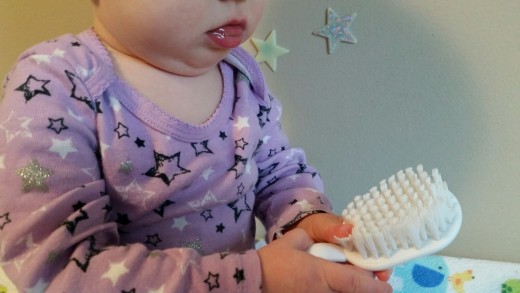
Teething Growth Chart
Child's Age
| Which Teeth?
| Fast Facts
|
|---|---|---|
4 to 7 months
| lower center incisors
| Teeth usually emerge in pairs
|
8 to 12 months
| upper central incisors
| Girls often get teeth before boys do.
|
13 to 19 months
| first molars on top and bottom
| Baby teeth are whiter and smaller than permanent teeth.
|
Social Play & Discipline:
One of the new things Imogen is doing is hitting my face and grabbing my glasses. She does this to other adults as well. This is a fun game for her, but not for me. She grabs my face and pinches sometimes, then laughs. But, I am very sensitive about my glasses as I cannot see well without them. So, I have to ‘discipline’ Imogen when she grabs my face or glasses. That means I hold her hands so she can’t get my glasses. I say, “No. Not my glasses.” to her. And if she persists, I put her down for awhile. This will help Imogen understand that I will play with her until she grabs my glasses, then we are done.
Another thing I say is, “I am not a jungle gym.” But, of course to Imogen I am, especially when I get down on the floor with her. She loves crawling all over me, standing by leaning or holding onto me and using me as an obstacle course. I also lay chairs on their side and move furniture to create an obstacle course that she and her older brother and cousin love.
The boys are now able to roll a ball or toy car back and forth to Imogen who loves the attention from the bigger kids.
As I mentioned elsewhere, Imogen loves, loves, loves playing peek-a-boo with grandpa and patty cake with me, or any adult who will indulge her. She loves to ‘rough house’ with us as well. I (and her dad) swing her around, or toss her up in the air. We lay her on our shoulder and pretend she is ‘super baby”. The boys love to be chased by ‘super baby’ and call her ‘baby shark’ with accompanying squeals of laughter.
However, since she is still little, we have to monitor the play – we can be wild, but not too wild so she gets hurt. Imogen doesn’t know that if she throws herself backwards it may hurt. Adults have to help her find the boundaries of rough play.
Literacy acquisition continues
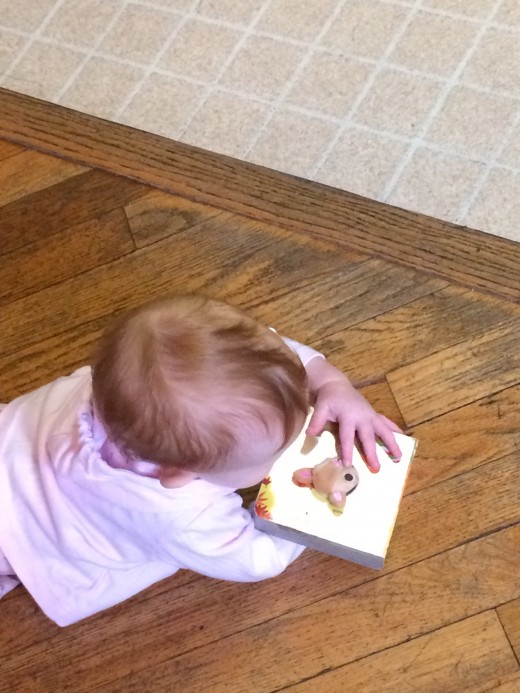
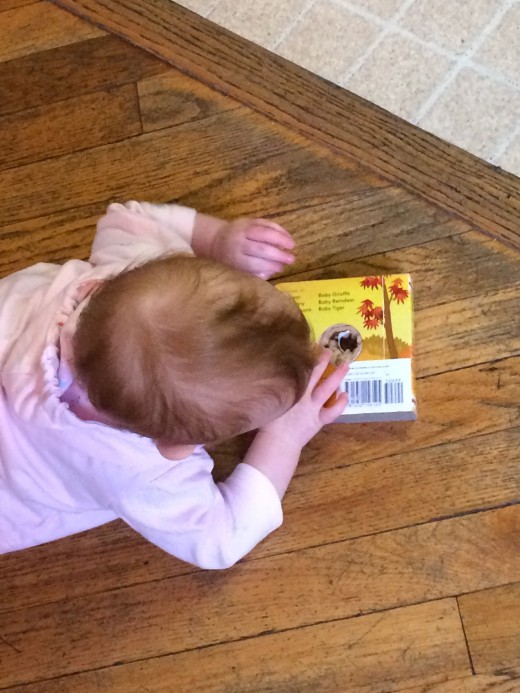
Summary
If you feel like you cannot keep up with your child’s growth, then your child is growing normally. I constantly clean the floors, check the outlets covers and board books. I make sure that there are no cords in sight or at least available. I cover the radiators and monitor the toys in case they break. Every day there is some new growth and new learning for me. I feel like Imogen is more dangerous to herself now because she is mobile. I love her energy and how much fun we have with her. But, I also need to help her not get overwhelmed with her own excitement or that of her brother and cousin as they play with her.
It is so important to remember that I am the adult and need to help our children be safe and healthy, so they can be happy. Our regular routines help Imogen discipline herself to sleep, eat, play at regular times. She anticipates the next thing because she is used to the routine. Now, as she moves into becoming an independent person, I have begin using physical barriers as well, to help keep her safe. And, as stated above, I am beginning to discipline by showing Imogen what she cannot do.
As Imogen grows, I will keep changing and adding to my discipline and safety strategies to help her grow while remaining safe and healthy.
Resources:
Baby Center expert advice at: https://www.babycenter.com/0_your-childs-teething-and-tooth-loss-timeline_10356447.bc?scid=mbtw_baby_post10m&pe=MlVHb3dUY3wyMDE3MTIwMQ..&liveconnect=7e7d1881bfebabd143c83f840b3de067babyc.425322
Video on Crawling at: https://www.babycenter.com/2_baby-on-the-move-crawling_1487380.bc
Video on Cruising at: https://www.babycenter.com/2_baby-on-the-move-cruising_1487416.bc
“Encouraging Baby’s Physical Development: 9-12 months” by Jamie Loehr and Jen Meyers at Parents.com at: http://www.parents.com/baby/development/physical/activities-for-physical-development-9-12-months/
© 2017 Annette Gagliardi


